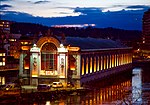Geneva University of Art and Design
2006 establishments in SwitzerlandGeneva University of Art and Design

Geneva University of Art and Design (HEAD), (French: Haute École d'art et de Design Genève) is a European art and design school founded in 2006, and belonging to the network of the University of Applied Sciences and Arts of Western Switzerland.
Excerpt from the Wikipedia article Geneva University of Art and Design (License: CC BY-SA 3.0, Authors, Images).Geneva University of Art and Design
Boulevard James-Fazy, Geneva Grottes et Saint-Gervais
Geographical coordinates (GPS) Address Nearby Places Show on map
Geographical coordinates (GPS)
| Latitude | Longitude |
|---|---|
| N 46.2089 ° | E 6.14132 ° |
Address
Boulevard James-Fazy 15
1201 Geneva, Grottes et Saint-Gervais
Geneva, Switzerland
Open on Google Maps








